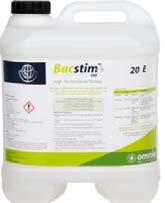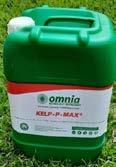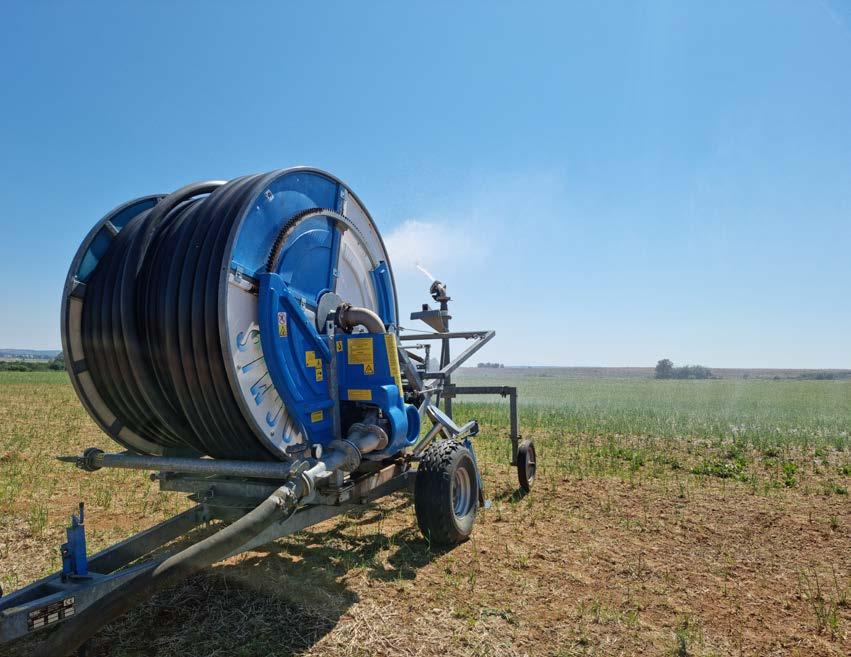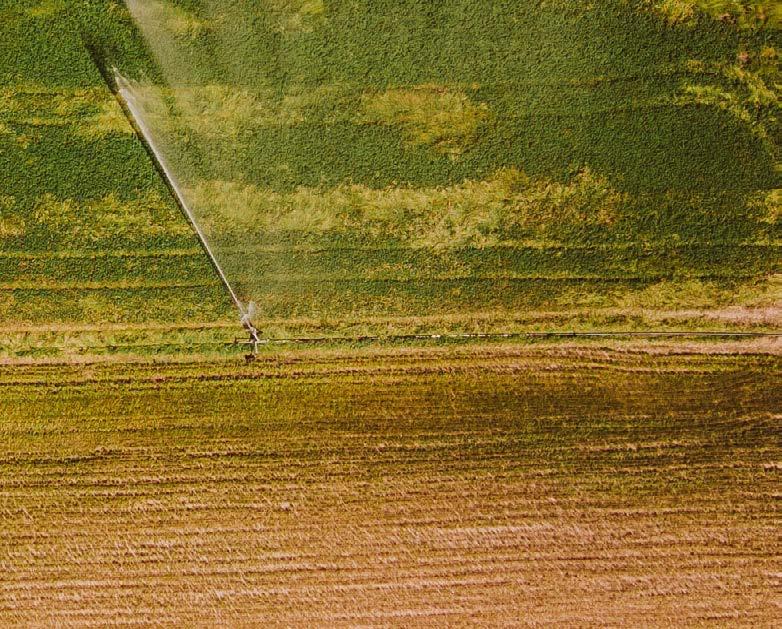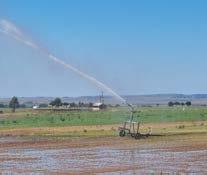Botswana / Namibia / Zimbabwe
page 20 page 33 page 42
era farmers in Africa




their



Botswana / Namibia / Zimbabwe
page 20 page 33 page 42
era farmers in Africa




their


A seasoned finance specialist, John Deere Financial runs so life can leap forward


John Deere Financial’s finance and credit products are provided in association with Stanbic Bank Botswana and Bank Windhoek Namibia.

*Terms and conditions apply (please follow the link to view applicable T&C’s: https://www.deere.africa/en/finance/financing/sub-saharan-financing/).
All advertised deals are subject to credit approval and the financing bank’s terms and conditions.

Scan the QR code to learn more


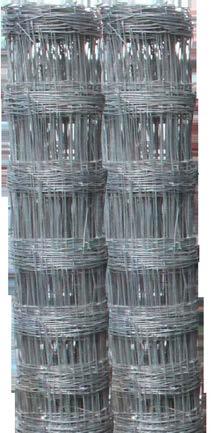















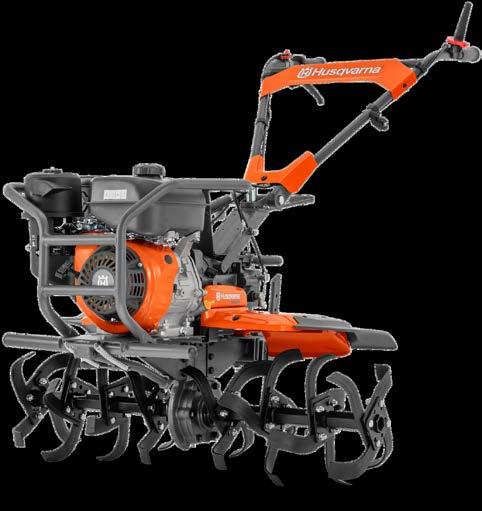





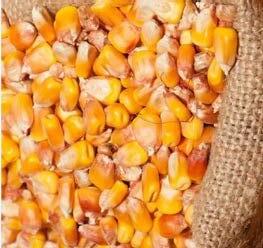

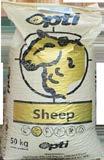











My memories of youth, growing up on the farm, include spending entire days climbing trees, hunting for earthworms to use as bait when fishing in the river, eating fruit fresh from the tree while still warm from the sun, catching crabs in the river nearby and riding along on the tractor with my dad.
It is not to say that children growing up in cities do not learn the lessons one learns growing up on a farm, but as a child growing up on a farm, I certainly learned to be innovative, patient and curious about the world; being aware of your surroundings, knowing that your animals depend on you to feed them, and understanding the importance of your daily chores; seeing animals being born and animals who die, and developing an understanding of the circle of life at a young age. As an added bonus, I also learnt a third South African language.
What growing up on a farm taught me included the true meaning of patience; when you see the results of endless hard days paying off. On a farm, your work is dictated by the weather and seasons, it is different every day and never ever mundane!
It is so heartwarming to read and hear all the success stories of farmers sharing their stories of the proof that patience pays off, eventually.
A farmer does not give up so easily. He, or she, will always find a way out because a farmer always makes a plan. Even though loadshedding negatively impacts farmers, they will always find a way out to continue to succeed despite all the challenges. If you do something, do your best to do it right. Make sure you are prepared for planting season. Make sure your cows' condition is right when you put the bulls in. You do not have many chances to do it right. Realise every season this is one season less to make the best of your farm!
However, patience does not only apply to the farming industry, but to any career that you pursue. Your dreams can come true no matter what they are, and time is necessary to live a truly meaningful life surrounded by lasting relationships and community engagement. It is not always easy, but it is worth it and rewarding in the end.
Good luck for the upcoming winter season and enjoy farming!
Jupidex is the supplier of world-class agricultural equipment and spare parts with exceptional service to the Sub-Saharan African market. Read more about their wide range of equipment on page 2.

577 Rossouw Street, Die Wilgers, Pretoria +27 (0)79 515 8708
www.proagri.co.za
Copyright © 2023. All rights reserved. No material, text or photographs may be reproduced, copied or in any other way transmitted without the written consent of the publisher. Opinions expressed are not necessarily those of the publisher or of the editor. We recognise all trademarks and logos as the sole property of their respective owners. ProAgri shall not be liable for any errors or for any actions in reliance thereon.
Editor Bianca Henning >
Reporters
Benine Ackermann >
Maryna Steyn >
Natasha Pansegrouw>
Specialist Writer
Annemarie Bremner >
ProAgri-greetings!
Bianca Henning bianca@proagri.co.za
Jupidex makes every farmer's dreams come true
John Deere aims for growth across Africa

Apimondia focus: Bee conservation in Africa
From silkworms to silk garments Part 5: Silk weaving

Fruit production part 6: Blueberries
Land management and rehabilitation part 1
Herb and spice production part 5: Challenges facing the spice industry


Financial literacy in agriculture part 2: Get to terms with the terms!

Wintering of ruminants: Feed wisely and farm efficiently
Veld fires and livestock: UP Faculty of Veterinary Science advises on animal treatment decisions
John Deere Financial provides personalised financial solutions and personal support
Pig breeds part 2: Southern African pig breeds

‘Warriors of hope’ inspired by Fruit Logistica
Snail production – Part 2
Lack of mechanisation slows smallholder ambitions in Zimbabwe
As seed prices soar, smallholders in Zimbabwe turn to old ways
Zimbabwe: Poultry farmers struggle to control disease & loss
+27 82-326-2572 bianca@proagri.co.za
+27 73-105-6938
benine@proagri.co.za
+27 82-261-9177
maryna@proagri.co.za
+27 81-736-4236
natasha@proagri.co.za
+27 82-320-3642
annemarie@proagri.co.za
Client Relations Manager
Carin Swartz >
Marketing Manager
Diane Grobler >
Marketing
Xander Pieterse >
Johan Swartz >
Tiny Smith >
Lynette van Tonder >
Creative Director
Christiaan Joubert >
Design
+27 84-233-0123 carin@proagri.co.za
+27 82-555-6866 diane@proagri.co.za
+27 79-524-0934 xander@proagri.co.za
+27 71-599-9417
johan@proagri.co.za
+27 82-698-3353 tiny@proagri.co.za
+27 74-694-4422 lynette@proagri.co.za
+27 72-419-3990 christiaan@proagri.co.za
Michelle Kruger Jamie-Lee Tromp
Enquiries
Engela Botha >
+27 12-803-0782 engela@proagri.co.za
Distribution and subscription
Nita Volmer-van Zyl >
Accounts
Ronel Schluter >
Business Manager
George Grobler

+27 79-515-8708 nita@proagri.co.za
+27 12-803-0782 accounts@proagri.co.za
Farmers' eyes sparkled again this year at the sight of the top of the range implements that Jupidex displayed at NAMPO. After all, Jupidex is a market leader in South Africa for the supply and support of high-quality agricultural equipment.
The latest technology that Jupidex displayed at NAMPO included a wide range of useful implements – soil preparation equipment, spreaders, haymaking equipment, feed mixers, sprayers, precision technology, and more.
Jupidex always strives towards finding better solutions for our farmers and therefore it takes a lot of effort to fit all Jupidex's superior tools in their two stands at NAMPO.
Davel Kirstein, National Sales Manager of Jupidex, tells more: "It is incredible to be able to see all our customers again at NAMPO. NAMPO offers a platform to introduce our new products to the farmers and the market. The interaction between the farmers and the feedback we get from them is very valuable to us, because it enables us to adapt to the farmers' needs."
Davel adds: “On top of events like NAMPO, we also hold many farmers' days, not only ourselves, but also with our dealers across the country. We also provide training for our dealers wherever we can and transfer technical knowledge to them so that they can better serve farmers and enable them to get the most out of our equipment."
This year, Jupidex exhibited even more equipment than the previous year at NAMPO. "We have also greatly expanded our own Kverneland range, and where there are needs, we have found products to fill the gaps," says Davel.




"We are also very proud of our full range of high-tech front-mounted, trailed and self-propelled Kverneland sprayers that we were able to show at NAMPO," says Davel.
"The one sprayer we would like to highlight is the Kverneland iXter B18 trailed sprayer with its combination iXtra front-mounted tank. The Kverneland iXter B mounted sprayer range is the fruit of years of research and development in close collaboration with farmers: it is today the most advanced mounted sprayer range,” explains Davel.
This sprayer range will take any farmer far ahead and is highly recommended for precision farming. The iXter B18 can work up to 24 metres wide and holds 3 000 litres of spraying liquid (1 800 litres in the back and 1 200 litres in the front) so you do not have to interrupt your spraying every now and then to fill up.
"An advantage of this combination is the fact that you can apply two different types of chemicals at once and have higher capacity and more volume," adds Davel.
For easy and simple mixing, the iXter sprayers also have the mixing bin mounted on the side of the sprayer, so no one has to climb up and mix inside the tank. You can work conveniently and see what you are doing.
New range of Kayhan Ertuğrul balers in the Jupidex stable Jupidex has also recently launched their new range of Kayhan Ertuğrul compression balers. The two balers showed at NAMPO were the Kayhan Ertuğrul 520 and 555. "We have already sold a few of these new balers to customers, and the farmers are very satisfied with the range. This is a high-quality baler that makes a lot of compact bales in no time. We look forward to selling even more of them to farmers visiting us," says Davel.
These compact Kayhan Ertuğrul compression balers have several safety mechanisms, with shear bolts in
various places to protect your baler.
The KE 520 also has a safety pin, which pops out when any problem occurs. This helps prevent you from breaking needles. The balers' knotting and tying mechanism is simple to maintain, easy to work with, and the parts for these balers are readily and freely available from Jupidex and their dealers.
“The Kayhan Ertuğrul silage cutters are also among our new products. They are available in two different models – the KE 125 and the KE 120. These silage cutters are very popular among smaller farmers, the African market, as well as farmers who do not want to wait for contractors but want to cut silage for their cattle immediately.
"The KE 120 is a single-row silage cutter. It is easy to use and maintain, with low kW requirements,” explains Davel.
"The KE 125 is a multi-purpose cutter that is suitable for cutting and chopping grain and grass crops. This cutter can be mounted on the front, rear, or side of your tractor. You also do not need a very large tractor. Its outlet chute can rotate 360 degrees to make offloading easy and eliminate
waste. It also has a drawbar at the back, which enables you to hook up a silage wagon, so you do not need an extra tractor for the wagon."
Both cutters' knives are automatically sharpened with the grindstone mounted in the cutter.
"We also had our new Toscano highspeed disc and power harrow at NAMPO this year. The Toscano high-speed tiller is available with working widths of six and four metres. We have already tested the new Toscanos in the Ventersburg/Senekal area and the farmers who worked with them were pleased with the implement. We hope to soon see more of these red implements making dust on farmers' fields," says Davel.


the baler stops to set up the net, the wrapped bale is placed neatly on its head on the ground. All these actions are controlled from the cockpit.
The range of McHale balers that farmers could admire ... and buy at Jupidex's NAMPO stand this year.



McHale's stalwart round balers
Jupidex is also well known for their stalwart McHale round balers. McHale balers are already known as the best money can buy because they take all the headaches out of baling.
New McHale Fusion 4+
"The McHale Fusion 4+ is our latest addition to the range," says Davel. "This baler features the new Profi-Flo technology, which is designed to increase crop intake and ensure a more efficient material flow. The Fusion 4+ is also ISOBUS ready and equipped with a scale that weighs each bale for you."
The Fusion 4+ is also a bale wrapper. When the bale chamber has finished its work, the bale is moved to the wrapping table to be wrapped. Once the wrapping action begins, the baler begins to form the next bale. When
One of this year's highlights at the Jupidex stand was the impressive and new-to-the-market Degelman Pro-till 40 high-speed tiller.
Less than a month ago, the first Izelmak SuperMix feed mixer also made its appearance. They are available in 12 and 8 cubic metres.

The Jupidex team at this year's 55th NAMPO harvest day: Philip Janse van Rensburg, Izél Grobbelaar, ZW Nichols, Jacques Le Roux, Davel Kirstein, JC Blignaut, Juandré Maré, Christopher Laubscher, Divan van Rooyen, Wessel Pretorius, and Arthur Bezuidenhout.
The Jupidex group is dedicated to introducing the latest agricultural and especially precision technology to farmers. Visit their website at https://www.jupidex.co.za or call (+27)33-3863574 for more information.
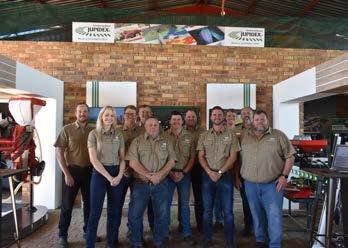
John Deere Financial’s finance and credit products are provided in association with Stanbic Bank. *Terms and conditions apply (please follow the link to view applicable T&C’s: https://www.deere.africa/en/finance/financing/). All advertised deals are subject to credit approval and the financing bank’s terms and conditions.
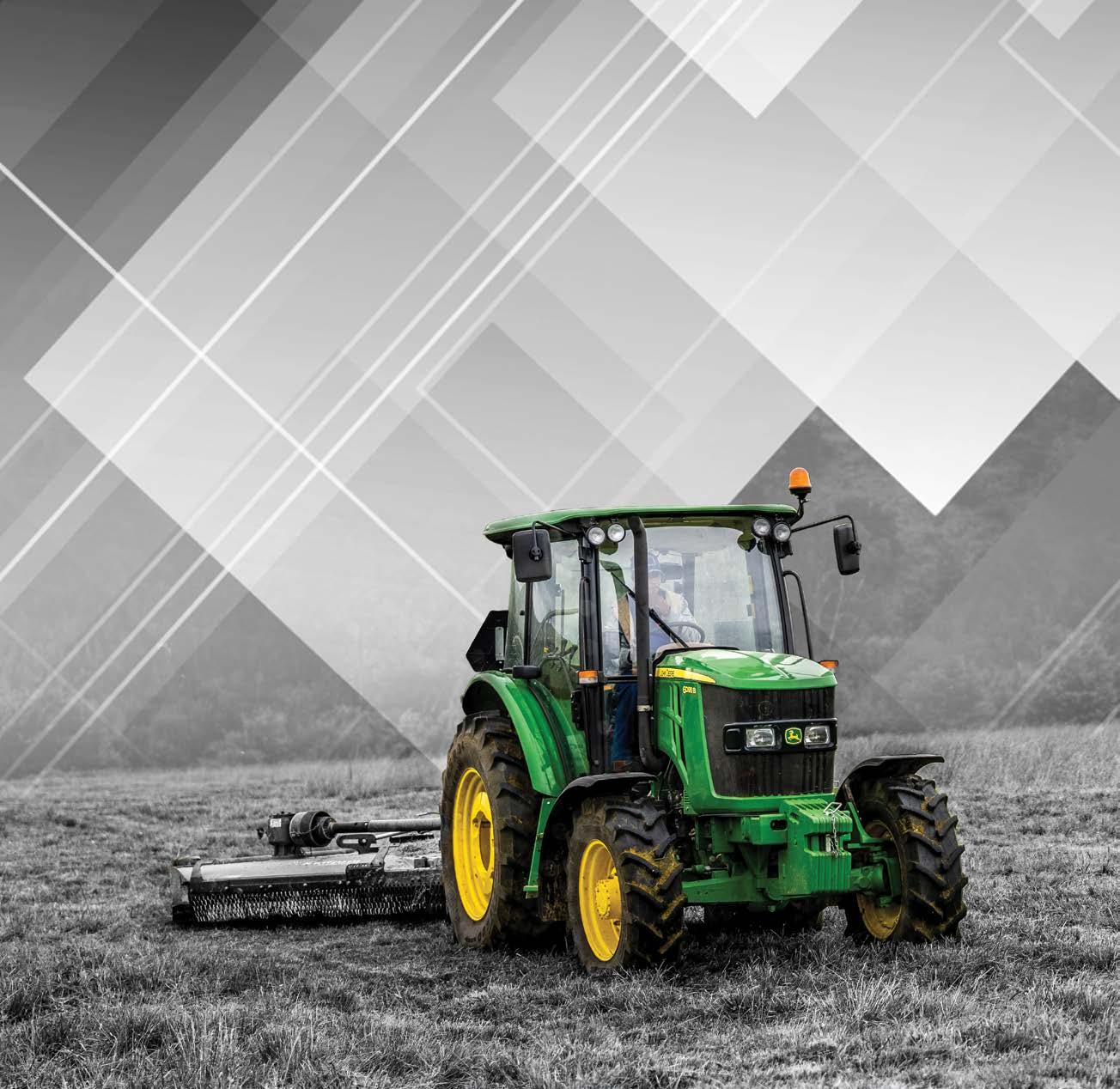
John Deere is a well-known name and brand across the globe. John Deere not only offers smart mechanisation solutions to farmers, but they also support and enable farmers in Africa to grow by providing smart solutions.

The John Deere SMART campaign is a bold initiative to raise Africa’s agricultural productivity by helping new era farmers to mechanise, improve yields and increase profitability. John Deere’s SMART programme has been helping smaller farmers improve yields and reduce costs across South Africa, as well as East and West Africa for the past few years.
SMART stands for:
S olutions for farmers
M echanisation for higher yield
A ccess to finance
Reliability for lower costs
Technology and training
John Deere lives the difference
Tell me and I'll forget. Show me and I'll remember. Engage me and I will understand. John Deere understands this saying, and also applies the message effectively in their SMART programme.
John Deere’s SMART model has the potential to revolutionise the agrarian sector, create jobs for the growing
youth population, and uplift the African population out of poverty through the establishment of vibrant mechanisation businesses.
"The John Deere SMART campaign is an initiative to increase Africa's agricultural productivity by helping new generation farmers with mechanisation, improving their yields and increasing profitability," explains Zabion de Wee, Business Development Manager of John Deere.
“With this concept, we are trying to eliminate the traditional way of accessing mechanisation, and supporting our farmers,” Zabion says.
He explains: “Instead of trying to sell tractors to smallholder farmers, John Deere identifies specific farmers who are interested in cultivating not only their own fields, but also those of their neighbours.”
By outsourcing their services to between 20 and 30 of their neighbours at an appropriate fee, John Deere believes they will be able to offer mechanised farming solutions to a larger number of smallholder farmers in Africa.
"We don't want to redesign the wheel. We are a mechanisation company, and we want to assist farmers with mechanisation," says Zabion.
One of the biggest challenges that farmers face is limited access to finance. John Deere’s support to farmers does not stop when the tractor is delivered on the farm. John Deere understands that access to finance has always been a significant stumbling block for most new era farmers for generations.
John Deere firmly believes in providing solutions to farmers to help them grow and achieve their goals.
“At John Deere, we do not believe in a “one-size-fits-all” approach to finance; we understand that new era farmers cannot be expected to have everything in place when starting up new agricultural operations,” Zabion adds.
John Deere, in collaboration with John Deere Financial, aims to assist new era farmers to overcome the barriers related to limited access to finance. By pulling in partners, considering other avenues of finance, and the constant generation of new ideas, John Deere is committed to the prevention of failure for the emerging operations of new era farmers.
John Deere offers creative financial solutions
John Deere Financial offers solutions that are tailored to the exact needs of their clients. The John Deere financial team assess clients as individuals alongside

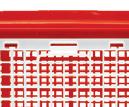














basic operational needs, and then provide agricultural asset finance packages tailored to the specific circumstances and mechanisation requirements.
This process is achieved in partnership with commercial banks and their comprehensive dealer networks; equipping clients with a team that can offer support and advice in making the best operational decisions throughout the entire process.
This professional relationship is beneficial to farmers; it allows farmers to focus on what farmers do best-farming.
Zabion highlights a few points on the drive behind the SMART programme:
• We are committed to seeing you through to your next harvest.
• We offer you a convenient experience by saving you time and coming directly to you, wherever that may be.
• We offer competitive financial solutions that are available to you through any of our dealer touchpoints across Africa and the Middle East.
• We provide you with insight by sharing our generations of expertise through our widespread dealer footprint.

• With a wealth of experience, we can help you make the best decisions for your business.
Zabion concludes: "We as John Deere



want to make a difference in food security. Our farmers have always been ready, we just had to find the right way to assist them in moving forward as we do. Giving them the right mentorship, and helping farmers grow, is our ultimate goal."
John Deere is with you every step of
the way, ensuring that new era farmers are at no point left feeling confused or struggling while starting up and running agricultural operations.
John Deere (www.JohnDeere. com) is a world leader in providing advanced products and services and is committed to the success of customers whose work is linked to the land – those who cultivate, harvest, transform, enrich and build upon the land to meet the world’s dramatically increasing need for food, fuel, shelter and infrastructure.
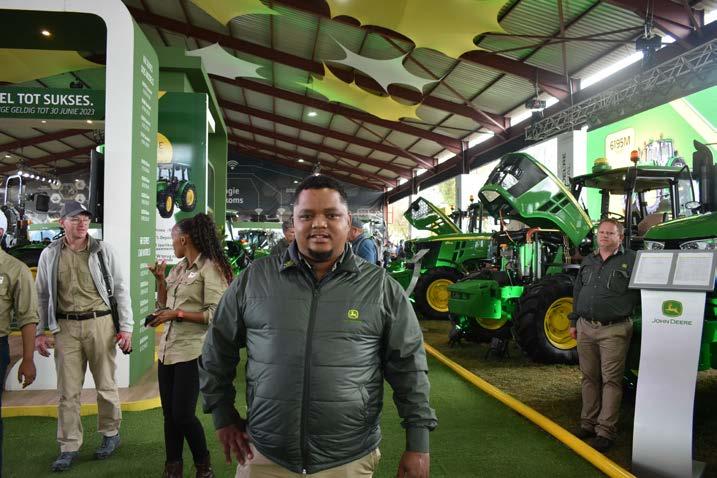
Bee conservation was one of the seven themes presented at the recent Regional Apimondia symposium held in Durban, South Africa. Five bee specialists from different countries in Africa shared their research and experiences on the theme.
Sisiphiwo Dingana presented a paper on the University of the Western Cape’s (UWC) crop trials in the Eastern Cape towns of Mthatha, Bizana, Port St Johns, and Matatiele. He offered an insight into the valuable traditional ways of beekeeping, which could contribute to preserving bee genetics.
Sisiphiwo is currently working as a postgraduate research assistant at the University of the Western Cape (UWC). He is leading the UWC Plant Research Assistance Crop Trial Programme in the Eastern Cape.
Insect samples, including honeybees, were collected during the past three years as part of these trials. While doing so, he searched for local beekeepers in the surrounding areas. “Surprisingly, most beekeepers were not registered at the Department of Agriculture, Land Redistribution and
Rural Development (DALRRD) or members of any beekeeping association.
I realised it is customary for people who are visited by bee swarms to let them stay in their homes for traditional benefits. It is customary that bees are ancestral,” said Sisiphiwo.
He found that bees are kept inside house closets, on the ground next to the kraals (villages), and under the roof ceilings. He used the opportunity to promote bee conservation, hoping that it would contribute to the publication of African indigenous bee-related knowledge. “Native bee-related knowledge may assist in recruiting more beekeepers to adopt sustainable beekeeping practices.”
His aim as a bee conservationist is influenced by the lack of public indigenous knowledge, food security, and nutrition with the potential for climate change impacts. “Indigenous people living in their local communities tend to interrelate and connect with their environments to make use of natural resources to manage the environments where they live.
“However, environmental, social, and economical challenges negatively impact this relationship. It has been argued that the conservation of native honeybees is crucial, as food security
systems highly depend on pollinators including honeybees in the wild or managed colonies.”

A decline in pollinators affects people’s well-being. Recent studies have outlined the lack of integrated management of native wild bees and managed agricultural colonies. “It is advisable to consider native peoples’ norms in beekeeping strategies to add value to integrated bee conservation planning. We should seek more indigenous knowledge to preserve the most crucial valuable bee genetic varieties at our disposal.”
Sister Mechthilde Faist of the Franciscan Sisters of Siessen, in Ladybrand in the Eastern Free State of South Africa, presented a lecture on apitherapy, a branch of complementary and alternative medicine that uses honeybee products, including honey, pollen, bee bread, propolis, royal jelly, beeswax, bee venom, and larval bees, practised at the mission. But there is a delightful, albeit surprising, twist to this bee house.
Born in Germany in 1957, Sister Faist moved to South Africa in 1983. She is entrusted with the management of the Regina Pacis Retreat Centre. Besides the use of bee products for health
purposes, visitors can also enjoy spending a relaxing time with bees. Inside a small house, like a garden house, some beehives are installed in such a way that a bench or bed can be placed over them. The bees have their own entrance area at the outside wall of the building so that their normal behaviour is not disturbed.
Inside the building, the benches or bee beds are sealed properly so that the bees do not have access to the room. Because of mesh wires over openings, the air, smell, vibration, and the sound of the bees fill the room. This experience is believed to have a positive and healing impact on the human body.
Dr Teresa Goszczynska has been a senior researcher at the Agricultural Research Council, Plant Health and Protection since 1994. Based in Pretoria, she is a bacteriologist, working with plant pathogenic bacteria and Paenibacillus larvae, the causal agents of American foulbrood in honeybees. Her research is aimed at isolating and identifying indigenous bacteria present in South African honey and bee bread that can inhibit P. larvae.
She believes microorganisms present in colonies play an enormous role in the health and vigour of these insects, which are threatened by many diseases, including American foulbrood (AFB). AFB is deadly to the brood and can result in the collapse of the infected colony.
Members of the Agriculture Research Council (ARC) made valuable contributions to the symposium. Standing is Roman Tladi, a beekeeper from Gauteng, Mammikele Tsatsimpe from the Gauteng Department of Agriculture, Land Reform and Rural Development, Dr Teresa Goszczynska (ARC), Thabang Nkgau (ARC), and Sam Mathibe (ARC), and seated Elizabeth (Elise) LundallMagnuson (ARC). (Source: Elise Lundall-Magnuson)

Clinical symptoms of AFB are present in the Western Cape. “It is intriguing that P. larvae have also been detected in other provinces, but the clinical symptoms were absent. There is a high probability that such colonies are protected by the naturally occurring P. larvae-inhibiting bacteria in their environment.
Charles Verster, of Ulwando Bushclearing in Johannesburg, South Africa, is a practising horticulturist, specialising in alien invasive weed control. He believes a strategy is needed to protect Eucalyptus trees for the benefit of honeybees. Besides developing vegetation management plants, he conducted


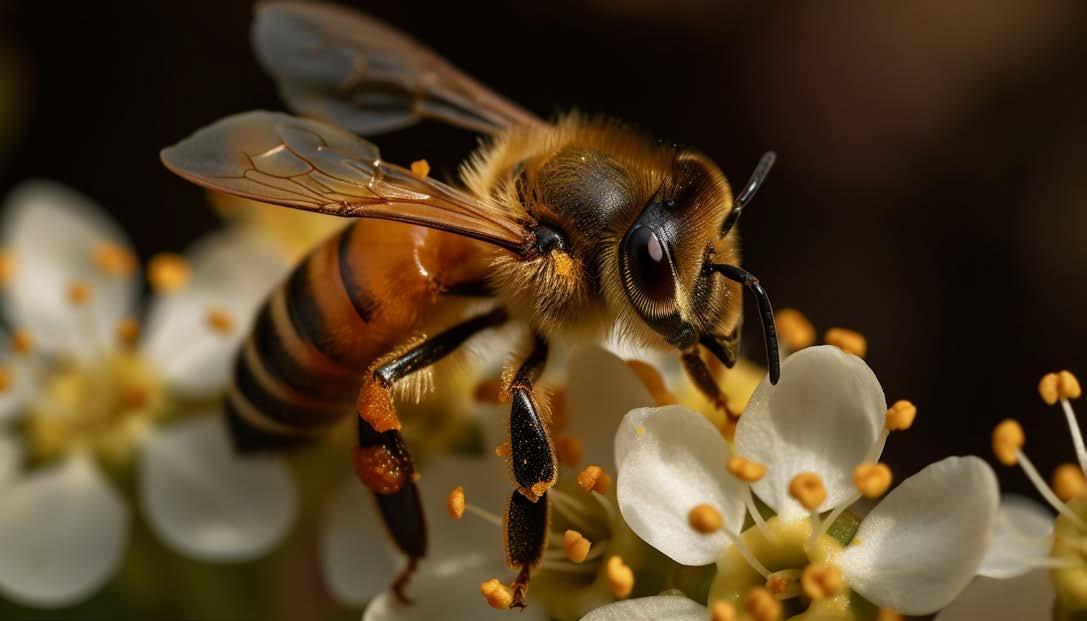
botanical assessment work. “For decades, there has been negative publicity regarding water consumption by gum trees and their related impact on biodiversity, which is the key driver behind the war against gum trees,” said Charles. “As a result of the eradication of Eucalyptus trees, especially from water catchment and riparian areas, beekeepers believe that their bee colonies and production have been significantly impacted.”
His presentation was aimed at stimulating thought and would hopefully be a catalyst in addressing some of the concerns in the quest to find solutions to boost honey production through Eucalyptus trees and or other species.
Pollinator decline in Tanzania
Dr Kathrin Krausa, of the Khan University, Arusha, Tanzania, is an entomologist with research interests in the communication behaviour of social insects, namely stingless bees, ants, and termites. Her current research focuses on the foraging and recruitment behaviour of African stingless bees with the aim of conserving and managing all pollinators.
“We are facing accelerating rates of changes in the environment and an ongoing loss of biodiversity that threatens ecosystem functions and services,” she said. “Flower-visiting insects and the ecosystem service of pollination they deliver, are not exempted from this.” She said evidence pointed to declines in important pollinators that could lead to food insecurity.
Like most other countries, Tanzania lacked a pollinator monitoring program
that would reveal changes in diversity over time, empower various stakeholders to make informed decisions underpinned by data and provide a measure for success.
The newly formed Aga Khan Research Station in Arusha, Tanzania is committed to tackling pollinator conservation and working towards holistic pollination management, including honey-, stingless-, and solitary bees to mitigate pollen deficits.


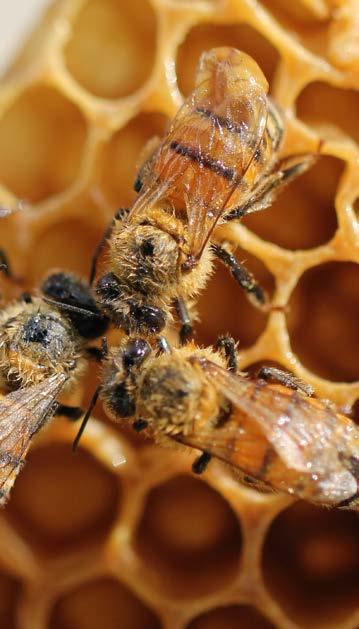

She concluded that it is important to raise awareness among farmers about the use of pesticides to preserve plant and animal biodiversity, ensure food security, and promote sustainable development.
For more information, contact Kai Hichert at (+27) 82-5610346 or send an email to hichert@worldonline.co.za
Some of the presentations are available for reading at this link: https://www.apimondiaafrica2023.org.za/scientificprogramme/
Namibiese Reg. N-AR 2162 Reg. Nr. L10856, Wet Nr. 36 van 1947
Reg. Nr. L10856, Wet Nr. 36 van 1947 Reg. Nr. L10856, Wet Nr. 36 van 1947






Namibiese Reg. N-AR 2162 Reg. Nr. L10856, Wet Nr. 36 van 1947




The silk must be woven into a fabric before the process is complete and the product can be sold. The procedure involves the interlacing of two yarn systems that run perpendicular to one another.
In general, weaving involves using a loom to interlace two sets of threads at right angles to each other: the warp which runs longitudinally and the weft (or woof) that crosses it. One warp thread is called an end and one weft thread is called a pick. The warp threads are held taut and parallel to each other in a loom.

Silk threads are held on bobbins on a frame called a creel. High-capacity creels are used in power looms. A horisontal creel can hold up to 400 bobbins. The central opening allows the worker to inspect and organise bobbin threads. Gathered threads are fed through a reed before being wound onto the warping drum.
byDepending on the width or ends of the fabric, the drum will prepare a specific number of sections after each one is made. The width of the fabric necessitates more warping machine sections and threads. A 400-bobbin creel, for instance, will have 400 threads in each bobbin.
Small warping devices are used in handlooms. Handloom weavers often make their own warp by combining threads into sections or balls and then warping a sheet.

Weavers use a process known as beaming to transfer sectional warp from the warp drum to the warp beam. In order to draw the reeds through the loom, the ends must be passed over a whip role, over and under the lease rods, and finally through the current of the heddle eyes of the respective heddles.
A pirn holds the strands and fits inside the shuttle that takes the weft strands through the warp strands for the actual weaving. The pirns are made small enough to fit in the shuttle's mounting system. The pirns used in power looms are typically larger and hold more yarn. Power loom weaving, then, requires a pirn winding machine. Automatic or manual pirn winding machines are available.
Back rest
Warp yarn
Heald wire
Reed
Woven cloth
Heald shafts
Warp beam Filling carrier
Filling yarn
Cloth roll
Heddle
Drop wire
Lease rods
Whip roll
Warp beam
Harness
Reed Cloth fell Front rest Shuttle
Lay Breast beam
Cloth roll
Components of a loom and their respective functions. (Source: Mahesha, Silk weaving)


The thread tension and coil distribution on an automatic pirn winding machine can be precisely adjusted, and the machine can immediately stop working if a thread breaks. The greater the yarn content and the more precisely packaged the pirn, the less often the shuttle will need to be stopped to replace the pirn, resulting in greater weaving efficiency.
This is executed using a warp beam. The strands are threaded over a whip roll, under the lease rods, and into the right heddle eye before being drawn through the reeds' dents. Reeding is the process of creating threads from reed.
Gating refers to the process of adjusting the loom so that the warp beam, heddle shaft, and reed are all at the correct height and angle.

When a warp is divided into upper and lower thread systems, the shuttle can move through the resulting gap, drawing the weft thread between the two sets of warp threads.
Power looms do it automatically, while hand looms require manual intervention, and handloom shuttles are smaller.
The movement of the shuttle between the sets of thread is called picking. As the shuttle travels across the loom, it releases a pirn of filling yarn. During a pick, one shuttle travels the length of the loom.
This is the process of pushing the weft tight to the already woven part of the cloth. A slay moves forward to beat the final weft pick and then back to clear the way for a shuttle in a shed.
The let-off motion is set up to let the warp out of the weaver's beam at a constant rate, keeping the warp tension steady as the weaving progresses.
The take-up motion is what winds the cloth onto a roller after it has been withdrawn from the weaving area at a constant rate to achieve the desired pick-spacing (picks/ cm). The ratio of ends to picks per centimetre is established by the take-up motion.
Handloom
A handloom is a simple, usually handmade weaving apparatus. Two distinct categories of handlooms exist:

1. The frame loom is a bit more upto-date than the pit loom. It may be set up in any regular home. When compared to pit looms, frame looms will take up less room.
2. The traditional loom is a pit loom, which is more robust and produces fewer vibrations during the weaving process. About five sarees can be made from a single ball of warp prepared for a pit loom. The weft is put into the weaving process in increments of one saree length using either a throw shuttle or a fly shuttle. The rate of production is really low.
An efficient weaver can produce about 3 metres of plain cloth every day. The leader of the family will do the actual weaving on the loom, while the rest of the family will undertake the preparatory work (warp and weft preparation).
Power looms come in two distinct varieties: The first type is an overpick, while the second is an underpick. Weaving silk is best done in an underpick.
If the weavers warp beam (which contains longer warp) is prepared in another part of the warping machine, weaving can continue for months. Power looms have one weaver and larger pirns to increase yarn capacity and decrease the frequency of shuttle replacement.
The average daily output is 10 to 15 metres. High-quality yarn is essential for weaving on a power loom. Since the warp ends are tensioned while weav-

ing, charaka silk is typically used for the weft while cottage basin or filature silk is used for the warp.
In the same way that some developed nations use automatic looms for cotton and synthetic weaving, they also do so for silk.
Automatic looms have a number of convenient features, including automatic letoff, pirn changing, break stoppage at the warp end, and break stoppage at the weft end.
By automating these processes, weavers can handle anywhere from six to ten looms at once. The output increases. Fabrics like sarees, saris, and checks predominate.
A weaver at her pit loom, threading her throw shuttle with a silk string. (Source: pexels by aiworldexplore)
Mahesha, H.B. (no date) Silk weaving, Weebly. Available at: https://hbmahesh.weebly.com/uploads/3/4/2/2/3422804/ silk_weaving.pdf
Textile weaving, https:// en.wikipedia.org/wiki/ Weaving.
Blueberries are a well-known fruit across the globe. The juicy, marblesized fruits are a culinary favourite, making its way into the muffins, pancakes, bread and breakfast bowls of consumers everywhere.
Although the market value of the humble blueberry has declined in recent years, farmers still invest in this crop as demand for the product rises. What, however, remains a challenge is the growing input costs that make the blueberry industry far less profitable than it used to be.

As a food source, blueberries are an excellent choice. They are chock full of iron, calcium, zinc, magnesium, and manganese as well as vitamins C, E and K. It is often processed into juice, flavourings, jams or puree. These berries easily freeze to keep for seasons when berries aren’t fruiting.
Throughout history it has even been used as a cough medicine and clothes dye.
Some blueberry varieties fare better in some climates than others. This is due to the differences in humidity and cold temperatures. The plants are relatively hardy as they actually need intense cold in the winter to optimally go into rest as this results in better yields. In extremely hot areas, the plants might require a little more irrigation in the warmer months.
You will need to research what variety is best suited for your climate. Some
varieties you can investigate include the O’Neal, Centurion, Sharp Blue, Brightwell, and Misty. It is best to plant more than one variety at a time. Some fruit earlier than others, so if you choose the right varieties, it is possible to have fruit six to eight months of the year.

The plant prefers more acidic soils, 4 and 5,5 pH. The plants also need full sun, so be sure to not plant them in shady areas. They also require soil that drains well and is rich in organic material.
Plant blueberries either in early spring or autumn.
When planting your blueberry plantation, it is necessary to use young plants that are propagated through cuttings. You can acquire these young plants from a nursery.
by Maryna SteynStart by digging a large hole, approximately 50 cm wide and 50 cm deep. Prepare the soil you have removed by mixing in some compost to improve nutrients and drainage.
Ensure that you leave 1,5 m spacing between plants as they spread up to 1 m in diameter. Rows can be spaced 1,8 m apart.
A blueberry bush growns up to 1,5 m in height. Once plants are established, these perennials can provide the farmer with fruit for up to 20 years.

Fertilise blueberry plants one month after planting.
A good water-soluble fertiliser that has nitrogen (65 g/kg) and higher levels of potassium (130 g/kg) can be used to fertigate every two weeks.
Be careful of nitrates as these can kill your berry bush.
Fertilise again after pruning.
Irrigation
Plants require regular irrigation, approximately 25 to 50 mm per week.
Harvesting
Blueberries flower in early spring whereafter fruits start to develop. Most commercial varieties are self-fertilising, so you should not have any difficulties when it comes to pollination.

The berries turn into a deep blue colour when they ripen throughout December and January. Berries that are ready to harvest are so ripe they basically fall into your hand.
Remember to prune the bushes after they stop bearing fruit. Only prune the weak stems that do not fruit, as well as those who will let in more light into the bush.
Blueberries are resistant to most pests and diseases, but if its environment isn’t taken care of, the plant can be susceptible to stress. Enough water, nutrition and suitable drainage will help avoid this.


Punnets of delicious blueberries. (Source: Veeterzy on Pexels)


Sources:
Blueberry grow guide (no date) GrowVeg. Available at: https://www. growveg.co.za/plants/south-africa/ how-to-grow-blueberries.
Plant blueberries (no date) Gardening in South Africa. Available at: https:// www.gardeninginsouthafrica.co.za/ autumn-is-a-great-time-to-plantblueberries#:~:text=Blueberries%20 are%20sweet%2C%20highly%20 nutritious,pests%20and%20 diseases%2C%20and%20will.
Growing Blueberries Grow Guide (2019). Stark Ayers Garden Centre.
Humans have been modifying their environment for thousands of years. The earliest modifications had little impact, but as human numbers and ingenuity increased, natural resources were gradually depleted and, in some instances, destroyed.
Ken Coetzee of Conservation Management Services, who gained valuable experience in managing natural rangelands as a rangeland manager, works in an advisory capacity in South Africa, but also in African countries including Morocco, Senegal, Malawi, Namibia, Kenya, and Botswana.
This series on land management and rehabilitation is based on the second edition of his updated book Caring for Natural Rangelands, published by New Voices Publishing Services in 2023, and is available from Ken (contact details below).
“I have observed that very few natural areas are completely free of the destructive legacy of modern landscape development,” he says. “Most often, the consequences of these landscape modifications suggest that the general attitude of landscape users has been one of careless exploitation, with little regard for the future implications of unsustainable land uses. Little or nothing is ever
replaced or returned to the land.”
As populations grow, they need more food. This led to the establishment of vast fields of monoculture crops, such as maize for food, or tree plantations for heat, shelter, and construction. The results are the deterioration of natural landscapes and the inevitable loss of biodiversity.
Signs of deterioration are everywhere as the result of economic industries, including agriculture, fishing, forestry, industry, housing, and even tourism, as humans take whatever they want or think they need from nature without putting anything back. Legislation, the lack of policing, as well as growing population numbers, poverty, corruption, and poor decision-making, are not helping to stop this deterioration.
The deterioration is most visible on rangeland, where over-utilisation of natural grazing and consequent erosion of the critically valuable soil reserves have resulted in the advance of desert and semi-desert conditions all around the globe.
At present, more than one-third of the earth’s land surface is vulnerable to desertification, with ten to twenty
 by Tisha Steyn
by Tisha Steyn
per cent of all drylands already lost to advancing deserts. According to Ken, these consequences are most prominent in and around the sub-tropical deserts of northern Africa, western South America, southwest China, and Australia, as well as the steppes of subtropical Asia and the countries around the Mediterranean Sea.
“Desertification can change lands that were once productive into useless wastelands and these changes have serious negative implications for biodiversity, human well-being, socioeconomic stability, and sustainable development the world over,” warns Ken.
He believes the increasing demand for natural resources, which are most often harvested or used in an unsustainable way, manifests itself as the desperate need for restorative environmental management. “However, habitat restoration or rehabilitation is prohibitively expensive and considered to be the field of expertise of a relatively small group of professional rehabilitation experts.”
Landowners, range managers and tenant farmers are usually confronted with rangeland management problems that were caused by previous poor management that did nothing to
address the results. As a result, problems such as erosion, deforestation and eventually desertification, get worse.

In this book, Ken does not dwell on the causes of landscape degradation or comment on who is to blame for it but rather concentrates on practical approaches that can be used to heal the scars and thereby give nature a chance to heal itself. “Nature is amazingly forgiving and will gratefully reward any kindness with astounding rejuvenation.”
He would like to inspire rangeland managers and farmers to take a fresh look at degradation and to approach the restoration thereof with a new attitude.
He quotes Aldo Leopold (1933), an American conservation writer who is considered the father of wildlife ecology and who was a renowned scholar, teacher, philosopher, and gifted writer of the book A Sand County Almanac (1933): “The hope of the future lies not in curbing the influence of human occupancy – it is already too late for that – but in creating a better understanding of the extent of that influence and a new ethic for its governance.”
Aldo Leopold believed that the land could be restored by the imaginative use of the same tools with which it was destroyed, namely the axe, plough, herbivores, fire, and mechanisation.

Leopold also believed that few
environmental fields depended as heavily on commitment, ingenuity, and resourcefulness as restoration management and that land care was an “integral component of the almost forgotten art of woodcraft which is based on the skills derived from individual and collective experiences of many generations”.
Ken provides some ideas of how the ever-widening gap in land care experience can be bridged by providing some ideas that may help with the restoration and rehabilitation of degraded rangelands. “The techniques described need not be followed to the letter. They should rather provide examples of how to think, understand and experiment, rather than be implemented as prescriptions.”
He believes there is no single or ‘correct’ way in which to approach rangeland restoration. “There are, in fact, endless answers or combinations of answers to every landscape restoration problem. A solution for each problem must be worked out according to its own specific situational characteristics, such as that of variability in soil types, climate, vegetation, land use, and land use history.”
Also, the approach need not involve elaborate or costly technology or highly specialised knowledge. “It should rather provide new insights and practical strategies for decision-making and implementation.”
The good news is that the solutions to many of the land care problems
that face land managers today are sometimes much simpler than is at first anticipated. He outlines practical and straightforward approaches as a way in which to get to grips with land management problems, no matter how small in the beginning. His methods are purposefully simple, and most can be implemented by unskilled or semi-skilled workers with some guiding supervision or limited training, and the tools already familiar to them.
Three interest groups must be motivated. These include:
• Land management practitioners, including farmers, game rangers, foresters, landowners, land managers, land management contractors, and rehabilitation consultants. These people will need methods and practical ideas about the planning and implementation of restoration projects;
• Environmental biologists, ecologists, botanists, zoologists, herpetologists, environmental scientists, and environmental agencies need to link their biological field of expertise with an improved understanding of the realities of practical field engineering; and
• Environmental education practitioners, including lecturers in environmental studies, teachers, extension educators and students of environmental studies, need to be provided with practical examples of successful rehabilitation options and the planning needed to implement them successfully.
“In short, we need to link practical land restoration practice with the range of individuals that may implement, study, regulate, finance, or have some other interest in land care projects,” says Ken.
Conservation Management Services
Ken Coetzee and Wallie Stroebel
Ken: (+27) 76-227-5056 or consken@mweb.co.za
Wallie: (+27) 82-493-1441
Website: www.conservationmanagementservices.co.za
The conversion of formerly productive arid land into deserts is widespread and occurs at an alarmingly rapid rate alongside human population expansion. by Maryna Steyn
by Maryna Steyn
Herb and spice production may offer smallholders the opportunity to expand their production or boost their income. But this doesn’t mean there are no challenges. Just like any farming venture, it is important to consider difficult factors within the industry at large.
Some of the issues the industry faces are more obvious than others. These include safety, quality and struggles to gain access to markets that support fair trade.

Most of the herbs and spices produced are intended for the food market. Whenever a product is manufactured with the aim of being consumed, food safety is a major consideration. Like all natural products, spices have the potential to be a breeding ground for microorganisms and pathogens. Salmonella spp., B. cereus and C. perfringens have all been found in these food products.
To circumvent this, it is necessary to treat the dried herbs and spices with processes that reduce the microbes. Currently, one of these methods is a high-temperature treatment. The issue with this is that it significantly reduces the flavour and aroma as the oils that give the substances its taste are removed through the process. Steam also has the same effect and has the added disadvantage of adding moisture that can further lead to mould.
In the past, fumigation with sterilising gasses such as ethylene oxide was used until it was identified as a carcinogenic and banned in 1991.
Irradiation is currently the most effective way to sterilise spices and maintain flavour.
Safety concerns include an increased awareness of the authenticity of the products that people consume. Not only is this relevant on the marketing end to ensure your product is consistent and
delivers the promise of what it is, but as a safety concern as well. Food allergens are dangerous and cross-contamination can easily occur, especially where the products are processed. This can also occur in fields where mustard (a known allergen) is, for instance, grown near other spices.
Steps should be taken to prevent contamination. Depending on where you sell the spice (locally or exporting international), it is good to research the food regulations in each country to ensure that you meet the guidelines.
Attention should also be given to packaging and storage requirements. There are specific storage requirements for each substance to prevent it from spoiling. Packaging needs to be safe and not interact with the spices. When spices are transported, packaging needs to keep the compounds stable and not affect the quality of the products.
The safety of products continues to be an obstacle for many growers and processors as it affects the market so deeply. If buyers or exporters cannot
guarantee the safety of the product, they would not purchase it. This means that the market channels can quickly and without warning dry up, leaving growers with a crop they cannot sell.
Quality of products is a major consideration of any business, but striking the balance between the outcome and input can be difficult. After all, what you put in is what you get out.
With skyrocketing prices for inputs such as seed and fertiliser, growers feel the pinch across all crop types, including herbs and spices.
To ensure the best yields, farmers, especially those who farm on a smaller scale, may also struggle with access to machinery and equipment that can make the farming task easier. These challenges also extend to other factors that can boost production, such as irrigation, which requires capital to set up and maintain.
Farmers can, however, ensure quality in other ways, such as stricter quality control. It will require the training of farmers and labourers in methods to improve the quality of the yield as well as to run quality checks on the products throughout the process of growing, harvesting, processing, packaging and delivery.
Training for the individuals who will conduct the tests will also need additional funds that may be difficult to obtain for the emerging farmer.

In Africa, the herb and spice industry is viable, but market access, sustainability and the struggles in the supply chain remain hurdles that producers and distributors need to overcome.
Market access is becoming stricter due to the safety requirements and the need for sustainable production.
Most of the growth in the African spice industry is driven by large role players such as Spice Importers and Millers CC, Freddy Hirsch Group, and Natpro Spicenet. Building relationships with the larger network of distributors will be the best approach for new spice farmers.
In recent years there has also been an increased focus on transport to provide farmers with access to ports of trade. With inaccessible roads and ever climbing fuel prices, farmers struggle to keep up with the challenges of getting their products to the buyer.
In the European market, the demand for more supply chain transparency is
a big driving force that influences the industry in Africa. But although the call for transparency poses challenges, it is a good shift in the long run. This is because farmers in the third-world countries of Africa who produce spices are more susceptible to exploitation. The demand for transparency promotes fair trade by ensuring traceability of products. A European buyer can for instance find out from a distributor where the product came from and the conditions under which it was grown and processed in Africa.
This, in turn, affects the competitiveness of distributors which is a good thing in the market place.

Sources:
Africa seasoning & spices market size & share analysis - industry research reportgrowth trends (2022). Available at: https://www.mordorintelligence.com/industry-reports/africa-seasoning-and-spices-market.

Global, A. (2023) Which trends offer opportunities or pose threats on the European spices and herbs market? CBI. Available at: https:// www.cbi.eu/market-information/ spices-herbs/trends.
Mikofu, J. (2021) Tanzania: Challenges facing spices value chain unveiled, allAfrica.com. Available at: https://allafrica.com/stories/202112130470.html
A Profile of the South African herbs and spices market value chain (2021) Department of Agriculture, Land Reform and Rural Development. Available at: http:// webapps1.daff.gov.za/AmisAdmin/upload/Herb%20and%20 Spice%20Market%20Value%20 Chain%20Profile%202021.pdf.
Skariachan, D. (2022) The Tuesday interview: ‘spice exports face unrealistic safety standards in developed countries’, Deccan Herald. Available at: https://www. deccanherald.com/opinion/thetuesday-interview-spice-exportsface-unrealistic-safety-standardsin-developed-countries-1152446. html.
Food safety is an important factor in the herb and spice industry. Products need to be free from microbes and contaminants. (Source: Pixabay)
Part of providing quality products means that sellers can confirm that the spices are indeed what the growers or distributors have promised. Products are not fake. (Source: Son Tung Tran on Pexels)
expenses payable to suppliers, accounts payable, and business loans.
Shareholders’ equity (SE) gives information regarding a company’s net value when liquidating assets to pay off debts. The shareholders’ equity is calculated by subtracting total liabilities from assets:
An income statement shows the business’s performance during a specific period. Periods commonly assessed are quarters (3 months) and in some cases may analyse the performance over a year. Focusing on revenue and expenses, the income statement depicts a company’s profit or loss.
Revenue refers to the income generated from a business’s operations and activities. One way to calculate revenue is by multiplying the price of an item by the quantity sold. Expense refers to money spent on utilities, salaries, and raw materials, and other costs that a company incurs operating the business.
In S&P’s Global Financial Literacy Survey, African countries score the worst in terms of financial literacy in the world. The most financial literate country is Botswana at 51% and the least is Somalia at 15% according to the survey. These statistics show just how much this status quo needs to be improved especially for smallholder farmers that may lack some secondary and tertiary education.
Quite a number of Sub-Saharan farmers end up outsourcing documentation processes that involve business terms or require some financial literacy, and though this is progressive, most of the farmers still remain without an understanding of terms used. It would be helpful to elaborate on the meaning of some financial terms commonly used in agribusiness, such as a balance sheet, assets, and revenue, just to mention a few.
Accounting encompasses the systematic recording and reporting of business financial transactions. Every process that involves the exchange and or movement of money around a business forms a part of accounting.

Accounts receivable is the amount
of money customers or clients owe the agribusiness for goods or services supplied. The total value of accounts receivable gives a snapshot of the amount owed to the business at any given time, whereas accounts payable reflects what the business owes creditors for goods or services supplied to the business.
A balance sheet is a document that presents a company’s financial health at specific points in time, usually at the end of the quarter or fiscal year. The balance sheet includes assets, liabilities, and equity, and follows the accounting equation:
The left side shows what one owns, whereas the right side shows what one is owed. Asset values should equal those of liabilities and equity.
Assets are resources that businesses control, in which the owner expects assets to generate future cash flow. Examples include inventory, equipment, and land. Liabilities are debts, usually sums of money that a business owes to another entity. Examples include
Profit , also known as “net income” or the “bottom line”, shows the difference between what a business earns and spends. Profit earned is calculated by subtracting total expenses from total revenue.
Net loss can be calculated using the profit equation. A net loss occurs when the total expenses exceed total revenue and the difference is negative.
A cash flow statement shows the cash generated (inflow) or used (outflow) by a company in a given period. Classify cash flow under operating, investing, or financing activities.
When it comes to profit margins, there are three types of profit margins. These are gross profit, net profit, and operating profit margin. Profit margin is obtained by dividing profit with revenue. Profit margins display a company’s growth potential and answer how much of each dollar of sale generates into profit.
Profit margin = (profit / revenue) x 100%
expenses payable to suppliers, accounts payable, and business loans.
Shareholders’ equity (SE) gives information regarding a company’s net value when liquidating assets to pay off debts. The shareholders’ equity is calculated by subtracting total liabilities from assets:
An income statement shows the business’s performance during a specific period. Periods commonly assessed are quarters (3 months) and in some cases may analyse the performance over a year. Focusing on revenue and expenses, the income statement depicts a company’s profit or loss.
Revenue refers to the income generated from a business’s operations and activities. One way to calculate revenue is by multiplying the price of an item by the quantity sold. Expense refers to money spent on utilities, salaries, and raw materials, and other costs that a company incurs operating the business.
Profit , also known as “net income” or the “bottom line”, shows the difference between what a business earns and spends. Profit earned is calculated by subtracting total expenses from total revenue.

Net loss can be calculated using the profit equation. A net loss occurs when the total expenses exceed total revenue and the difference is negative.

A cash flow statement shows the cash generated (inflow) or used (outflow) by a company in a given period. Classify cash flow under operating, investing, or financing activities.
When it comes to profit margins, there are three types of profit margins. These are gross profit, net profit, and operating profit margin. Profit margin is obtained by dividing profit with revenue. Profit margins display a company’s growth potential and answer how much of each dollar of sale generates into profit.
It is important to note that more revenue does not always translate to higher margins and more profit resulting from sales.
Return in Investment (ROI) is a ratio measuring performance efficiency relative to how much a company spent on investments. ROI is determined by dividing net profit by the investment cost.
Variable costs are costs that change proportionally to production. For example, the cost of raw materials increases with the number of units purchased. Unlike variable costs, fixed costs stay the same regardless of changes in production. For example, a company pays the same amount in monthly rent.
A cash flow is a measure of the amount of cash generated (or lost) through a business’s operations. It's different from net profit as net profit includes non-cash expenses (such as depreciation), and excludes some uses of cash (such as capital expenditures for new equipment, or repayment of outstanding debt).
Business to business (B2B) are transactions that occur when a company sells goods or services to another company and business to consumer (B2C) transactions occur when a company sells
goods or services to end-users.
Best practices are standard methods for executing a task to ensure effective results.
A deliverable is a final product given to the client at the end of a project. A deliverable can include information decks, research, financial models, and actual products for sale.
20 key business terms every professional should know. (2023) Available at: https://www.suitably.com/blogs/ well-suited/20-key-business-termsevery-professional-should-know Practical business terms. (2023) Available at: https://www.practicalbusinessskills.com/resources/ glossary-of-terms
Basic financial terms. Available at: https://www.studysmarter.co.uk/ explanations/business-studies/introduction-to-business/basic-financialterms/
Wood, M. (2020). Business finance. 60 Business and Finance Terms You Should Absolutely Know. Available at: https://www.fundera.com/blog/business-finance-terms-and-definitions
Hayes, A. (2022) What Is a Business? Understanding Different Types and Company Sizes. Available at: https://www.investopedia.com/ terms/b/business.asp
CFI Team (2022) Financial Literacy - The cognitive understanding of financial components and skills. Available at: https://corporatefinanceinstitute.com/resources/management/financial-literacy/
Winter is properly rearing its head with the first frost that had already occurred in places. The unpredictability of nature always presents challenges and can catch even experienced farmers off-guard. It is therefore of the utmost importance to not only rely on what the weather prophets say.
Even if a wet winter is predicted, our planning should rather be to prepare for the worst. Farmers who act proactively will reap the benefits in the form of cost savings and better production.
The challenges that the winter months pose to livestock farmers can easily be overcome if a farmer plans

 by Bianca Henning
by Bianca Henning
for it throughout the year. Challenges that farmers should provide for are the quality and quantity of grazing available in the winter period, veld fires, unusually long winters, as well as production targets that must be achieved to farm profitably.
As seasoned farmers always say, you should never run out of plans. Based on the information provided by nutritionists, ProAgri compiled the following tips on feed flow, feed requirements, and other guidelines to tackle wintering as practically and economically as possible. The timing of the placement of winter licks is extremely important.
Knowledge of the existing nutritional resources to provide the right supplements for your animals, is the key secret to the successful wintering of your cattle so that they can maintain condition and achieve the long-term goals for reproduction.
Lick programmes and lick intake
One of the most important factors in determining how much feed should be provided, is the fact that feed intake is the crucial driver of livestock production. After the first frost, the nutritional value of the veld decreases drastically, and it then consists mainly of fibre.
Lick can supplement the nutritional value. It is therefore important to provide a good protein lick as soon as the first frost appears.

Lick intake is also a good indication of roughage quality and availability. The lower the roughage quality or its availability, the higher the lick intake of ruminants. Lick can be a large part of a farmer’s input costs, but if lick is used judiciously, it is very cost effective. It is therefore important to follow a wellplanned lick programme. Please note that lick only serves as a supplement to the limited nutrients or nutrient values from grazing. It is not a feed in itself. Lick is only recommended when there is sufficient grazing or other roughage available.

The economic maintenance of body condition is of cardinal importance in any wintering programme. Ruminants create energy from digestion of feed, but they also need sufficient protein to feed the rumen microbes that help to digest the feed. To measure the feed requirements of the livestock and the availability of the different feed sources, the terms dry matter (DM) and dry matter intake (DMI) were created. This is the value of the feed, without the effect of moisture and other aspects, to determine and balance the roughage intake of the animal accordingly. Wintering of livestock remains one of the biggest challenges for any livestock farmer.
The following guidelines or principles are important:
Adequate quantities of roughage in the form of saved grazing are a prerequi-



site for successful wintering of livestock on winter fields. Supplementation should be given from as early as midMarch, even earlier depending on the season. Weighing animals regularly can determine exactly when growth stops, or weight loss occurs.
Supplementation should not be stopped after the first rain, but only when enough edible material is available in the spring to cause lick intake to drop drastically.
When non-protein nitrogen or (NPN) such as urea is used as a protein source, a limited energy supplement is essential to achieve the best utilisation of urea. When urea is used in winter licks, it remains economical and beneficial for body mass to add a small quantity of ammonium sulphate.

Phosphorus supplementation has a suppressive effect on body mass and should not be included in winter licks for dry animals. If the volume of your winter grazing is a problem, get rid of old and surplus animals in time.
Preserve your cash flow and take care of the core herd. It is important to decide which animals are the producing ones, and to maintain them in the best possible condition.
Good grazing management remains the key to success for wintering in the summer rainfall areas of Africa. It is important to adapt the animal numbers to the climatic conditions each year so that your core herd’s condition is maintained, longevity can be ensured, and long-term reproduction goals can be achieved.
The late dr Jasper Coetzee was well-known for his excellent knowledge of sheep farming.
ProAgri is grateful that a legend in the agricultural industry, dr Jasper Coetzee, made his Manual for Profitable Sheep Farming available to the readers of ProAgri. His revised ‘A guide to profitable sheep farming’ is now available as a hard copy or an online version. If you want to obtain more information about profitable sheep farming, order your Manual for Profitable Sheep Farming today by sending an e-mail to: mvs@meadowcape.co.za
Veld fires are common in South Africa, and according to local studies will increase in frequency over the next three decades. Farmers are emotionally and financially affected by fires, sustaining losses including feed, facilities, livestock, and future performance of surviving livestock exposed to smoke.

The decision-making process about treating animals affected by fires therefore needs to integrate several factors, including severity of the burn and its clinical prognosis; availability of skilled personnel to care for the animals; adequate shelter, feed, and water; cost of treatment; and longterm consequences for reproductive performance due to smoke exposure.
Offering prognostic hope for moderately burned animals without neglecting their welfare, as contemplated in local legislation, can help mitigate the sense of loss that farmers experience in these situations.
Live tissue burns are the most common lesions observed on livestock victims of veld fires. These lesions occur due to direct contact with flames or due to heat radiation from flames. Management of severe burn lesions is difficult due to the type of care and resources needed, costs involved, and the length of the healing time.
Massive loss of fluid and electrolytes leads to shock in animals with partialthickness burns (second degree) of more than 15% total body surface area
(TBSA) and/or more than 5% TBSA full-thickness burns (third degree). Hence, lifesaving intravenous fluid therapy (resuscitation) is necessary in these cases. Moreover, smoke inhalation can severely affect the respiratory system and increase the severity of the burn injury, although it may not be detectable over the first 7 to 10 days.
During veld fires the first challenge is accessibility to the affected area, followed by resources to move animals to safer ground. The first approach in such situations would thus be to visually identify animals that would benefit from being moved to receive care immediately, and those that need to be euthanised immediately (first line assessment/ FLA). At this stage, injured animals will be mainly evaluated on how they present (comatose vs alert) and mobility (can walk vs can’t rise/walk).
Comatose sheep have been reported to have a hopeless prognosis within the first 24 hours, especially if combined with severe burns on lower legs and heavy swelling on the head and front limbs. In general, burned animals with an inability to stand and move have been correlated with poor survivability, hence euthanasia is indicated.
It is important to bear in mind that, in most cases, treatment will be done based on veterinary resources available on a mobile setting; this means identifying animals with the best chance of response to treatment is a priority.
Thereafter, a more detailed treatment plan can be developed according to the evolution of the patient.
The second stage would be to physically examine animals identified as possibly benefiting from treatment intervention. Some will be in burn shock, need intravenous fluid, and have respiratory affectation, although this process can take up to two weeks to be evident. Farmers should seek veterinary advice regarding treatment needs to make cost-effective decisions.
When evaluating burn lesions, it is important to determine the extent and depth of the burn body surface, which will provide an indication of the severity of the injury and will help in determining the case prognosis.
The following anatomic areas have been defined as percentages of the total body surface: head 7%, back 7%, left costal wall + left abdominal wall 24%, right costal wall + right abdominal wall 24%, udder 4%, ventral thorax and abdomen 7%, each foreleg 4% (8%), each hindleg 6% (12%), perineal area 6%, and tail 1%.
Survivability of the animals is associated with the percentage of body affected, and decreases with the extent of the burn:
by Dr Claudia L Cardoso and Prof Rhoda Leask Botswana(Source: www.mdpi.com)
• 10 to 20% TBSA partial-thickness burns: 100% survivability, although these animals will need basic fluid therapy.

• 20 to 50% TBSA partial-thickness burns: approximately 87% survivability with intensive care, which will include aggressive fluid therapy, maintaining a clean wound with daily nursing, and pain relief.
• 50 to 70% TBSA combined partialthickness and full-thickness burns: 27% survivability under specialist care.
In all cases survivability substantially decreases with smoke inhalation and critical location burns.

Burn injuries are commonly found in the fac e, ears, mouth, and lower body (limbs, feet, and udder) in ruminants.
Sheep not shorn will have wool protecting their skin, but bare areas will be fully exposed.
Movement-restrictive lesions on the limbs, such as affected claws, prompt the need to provide feed and water within reach, and special soft bedding. Moreover, these can eventually be movement-restrictive for the animal due to scarring constriction once healed.
When reassessing animals, those with more than one lost claw should be euthanised, as the condition is painful and prone to fly strike and/or secondary infections. Hence, damage to the legs is an important indicator of surviv-
ability in sheep.
However, burned legs in restricted areas not associated with swelling have been reported to heal with appropriate care in approximately 30 days.
Monitoring body weight is also an indicator of survivability. Endoparasite control in burned sheep under treatment is important, as it can become an added complication due to immunosuppression. Control measures for these ailments should always be considered in the treatment plan.
Cattle feet burns are more serious than in ovine animals. Cattle will not move to eat under these circumstances, hence nursing injured cattle will be a costly and lengthy process. Euthanasia is indicated when the animal shows severely affected limbs and/or no improvement despite treatment, along with worsening body condition.
Burned udders also need special consideration, as they may be important for future performance.
Mature dairy cows affected by teat burns heal quicker and more satisfactorily, with less anatomic distortion and successful return to normal lactation in comparison to heifers. Healing time

for extended superficial burns in adult cows is about four months and usually has a good prognosis, although it needs pain management.
Partial-thickness burns have poorer prognosis when time for recovery for subsequent lactation (especially in heifers) is three months or less; bending of the teat and obstruction of the teat canal have been reported as a complication in young animals, which makes prognosis poorer. Topical treatment with emollients and antibiotics is advocated, and systemic antibiotics are only used in case of complications such as mastitis.
Once established that the animal will be treated, the first action will be to stop the progress of the burn by applying running cold water (not chilled) for about 10 to 15 minutes. This will reduce the temperature of the tissue and stop the lesion progress. Meanwhile, if the case requires it, a qualified professional should open intravenous access to institute fluid therapy, pain, and anti-inflammatory management, as well as systemic antibiotics if required. Cases where there is respiratory affectation need to be evaluated by a veterinarian to
decide on the best approach.
After cooling and gently cleaning the burn lesion, apply abundant topical cooling gel, antibiotic cream with aloe vera and/or local anaesthetic, and cover with nylon film to avoid contamination, until the animal can be evaluated by a veterinarian.
Fires will unavoidably become a more frequent occurrence worldwide; hence disaster management pr eparedness is nec essary to contain losses, and a transdisciplinary group of trained professionals should work towards the recovery of the affected community.
Categorisation of burned animals should follow welfare and cost-effective premises, as this is amongst the core considerations in the context of production animals.

Case prognosis based on burn severity is only one of the considerations for decision-making, as other factors – such as location of the burn, smoke inhalation, and availability of resources during recovery – play an important role in the success of the decision.
This approach will greatly reduce losses due to mismatching needs and resources in the aftermath of veld fires.

Dr Cardoso is a Lecturer of Ruminant Health and Production at the Department of Production Animal Studies at the University of Pretoria's Faculty of Veterinary Science.
Prof Rhoda Leask is a Professor in Ruminant Health Production at the Department of Production Animal Studies at the University of Pretoria's Faculty of Veterinary Science.
Kindly refer to the information below in order to complete a burn triage survey before 26 July 2023 by either clicking on the link provided or scanning the QR code with your smartphone.

https://pretoria.eu.qualtrics.com/ jfe/form/SV_0j4K6AVbp2w8ZkW


ProAgri thanks UP Faculty of Veterinary Science for the information supplied in this article.






When it comes to innovative finance solutions, John Deere Financial empowers businesses worldwide. With our rich heritage, John Deere Financial has been a trusted partner in the agricultural, construction, and forestry industries. From flexible financing options to equipment leasing and insurance programmes, we combine deep industry knowledge with cutting-edge technology to drive the success of operations in these sectors.
At John Deere Financial, we’re committed to seeing your business succeed by enabling you to get the best equipment through personalised financing and one-to-one support so that you can run your business with the utmost efficiency, whatever the season.
John Deere Financial understands that we live in an ever-advancing world, with agricultural demands increasing and technology progressing at a fast pace. We want our clients to access the latest John Deere technology – so life can leap forward.

Advances in banking and agricultural technology give us the opportunity to think differently about agricultural financing. We work closely with our alliance partners to ensure that our financial offerings enable efficiency. These strategic partnerships also empower us to offer attractive interest rates and flexible financing options that cater to the unique demands of the agricultural sector.
Because we recognise the cyclical nature of the agricultural industry, John Deere Financial makes it possible for your business to leap forward wherever you are in your cash flow cycle with our specific, personalised services.
Moreover, we firmly believe in the power of personalised support. Your John Deere Financial finance specialist knows your industry and your business – they understand the nature of this sector and the particular cashflow challenges you might face.
With their guidance and expertise, you can receive a customised service, enabling increased profitability and growth. From small-scale farming to commercial, our John Deere Financial specialists possess extensive knowledge of your industry, offering expert sector-specific advice and support.
John Deere Financial has a significant role to play not only in the agricultural sector but also in the construction and forestry industries. Leveraging our expertise and experience, John Deere Financial provides specialised financial solutions that support the growth and success of businesses operating in these sectors.
In the construction industry, where heavy equipment plays a pivotal role, John Deere Financial offers financing options personalised to the unique needs of contractors, builders, and construction companies. Whether it's excavators, loaders, dozers, or graders, John Deere Financial provides flexible financing plans that enable businesses to acquire the necessary equipment while managing cash flow
effectively. By partnering with John Deere Financial, construction companies can optimise their operations, increase productivity, and stay competitive in a dynamic market.

Similarly, in the forestry industry, where equipment reliability and performance are crucial, John Deere Financial offers financing solutions that allow businesses to invest in forestry machinery and equipment. From harvesting equipment to forwarders and skidders, John Deere Financial understands the specific requirements of the forestry sector and provides financing options that align with the seasonal nature of the industry.
John Deere has always worked to offer financial solutions to clients ever since we allowed farmers to purchase their first ploughs on credit. We’re a dedicated business partner that will see you through season after season, year after year. Efficient internal processes and digitalisation enable us to offer personalised solutions, maintain strong client relationships, and run, so life can leap forward.
John Deere Financial’s finance and credit products are provided in association with Stanbic Bank Botswana and Bank Windhoek Namibia. *Terms and conditions apply (please follow the link to view applicable T&Cs: https://www.deere. africa/en/finance/financing/ sub-saharan-financing/). All advertised deals are subject to credit approval and the financing bank’s terms and conditions.





Pigs are popular as a source of food and income due to their rapid growth rates, high feed-to-meat conversion ratios, low area requirements, high reproductive capacity, and calm temperament.
This is why it is thought that humans already domesticated pigs 9 000 years ago.
Breeds available in Southern Africa:

The Kolbroek is a South African breed with a long history. The breed's characteristics: resilience, docility, good foraging skills, and the ability to get by with very little, making it ideal for outdoor production. They will eat anything from discarded fruit in an orchard, to leftover vegetables from the kitchen, to crop remnants in the garden.
In addition, they are less likely to suffer from sunburn thanks to their dark skin. The sows are gentle and productive as breeding stock. They have an average rate of reproduction, with litter sizes ranging from six to nine piglets.

Due to the breed’s perceived slow growth rate and a cultural stigma, kolbroek meat is not popular in the mass market, but its popularity is growing in
the traditional, slow food, and freerange food sectors.
The Kolbroek pig is an adaptable breed. When used in breeding programmes, crossing with breeds like the Duroc and Large White results in
offspring with better growth rates, feed conversion, and carcass quality. The offspring can be sold at 90 to 100 days of age, making them ideal for sale on small farms and smallholdings, or to feedlots.

The Belgian village of Piètrain is the birthplace of this white-and-black spotted breed. This medium-sized breed is stockier and wider at the shoulders, with shorter legs than most pig breeds.

When compared to other black or black-spotted breeds, the black hair on these pigs is not as darkly pigmented. At around eight months of age, the boars have developed sufficient muscle and are ready to be used for reproduction. They are typically crossed with other breeds in an effort to increase meat production. While the sows may be productive, they tend to be poor mothers.

The hams are enormous and muscular. They have an incredibly high lean-to-fat ratio. This breed is highly sought after for fresh meat processing due to its well-deserved reputation for exceptionally high-quality lean meat.
The breed's sows have a high reproductive rate, but they do not make the best mothers and do not produce much milk.
The Large Black is a breed of large, all-black pigs that descended from the Old English Hog, a pig breed that first appeared in England in the 16th and 17th centuries.
The breed's coat colour, resilience, good nature, and skill as a forager make them ideal for outdoor production. Additionally, they are less likely to suffer from sunburn than white breeds. The sows are friendly, productive, and excellent mothers who produce plenty of milk.

The meat has gained a negative reputation over time due to the breed's black colour, and baconers have shied away from it because the black pigment (high levels of melanin) makes the meat look like it contains round black seeds. It is possible, however, that there are niche markets for large blacks and their crossings, particularly in the traditional, slow food, or freerange markets.
Large Blacks are only slightly smaller than the Yorkshire pigs. They have elongated heads, square faces, and lopped ears. The bodies of Large Blacks are of good depth, moderately long, and backed with strength. The black pigmentation is dense, and the hair is fine and thick.
The breed is known for its resilience and thriftiness, and its light shoulders, good sides, and hams have earned it praise. While the breed's mothering skills and litter size are above average, it does not appear to mature as quickly as some others.
Many years have been spent crossing the Large Black with the Landrace to create a top-tier F1 (first generation offspring) mother. These F1 Large Black and Landrace hybrids have performed exceptionally well in outdoor
The Large Black breed has above-average litter sizes, but they do not mature as quickly as some other breeds. (Source: za.pinterest.com)
Their massive size was both praised and criticised, but their prolificacy, hardy vitality, foraging ability, and exceptional carcass qualities won them widespread acclaim.
This breed has a longer neck than other common commercial breeds. The first animals of this breed were brought to South Africa in the 1980’s so that local breeders would have access to a new genetic pool. While the breed is still widely used in the United States, its dark skin and the presence of a gene that reduces meat quality have caused it to fall out of favour in Europe, Canada, and even South Africa.
The sows have large litters, but they are not known for their parenting skills. The temperament of sows and boars is mild. Some Hampshire boars lack sexual aggression, and low libido is a common trait among the breed. Due to the presence of coloured hair follicles, it is recommended that the offspring of this terminal sire contain no more than 50% Hampshire genes.


References
Pig Farming in South Africa. (2022). Available at: https:// southafrica.co.za/pig-breeding. html
Breeds of Livestock - Breeds of Swine, Department of Animal Science. (1996). Available at: https://breeds.okstate.edu/swine/ index.html
Pig Breeders Society of South Africa. (2023). Available at: http:// pigsa.co.za/

Hampshire
experiments. However, the Large Black is a large pig, and some colour showed up in the first cross. To get a white slaughter generation from F1 Large Black and Landrace hybrids, it is suggested that a Large White boar be used on the females. Two major obstacles to the breed's future development are the lack of available stock and the inherent stigma attached to the breed's black colouration.
The Hampshire is one of the ancient pig breeds of England. The Hampshire belongs to the belted breeds, so called because of the white skin and hair belt that runs from the shoulders down the front legs and feet of the breed.

Nigel Klaasen, the 2022 Western Cape Prestige Agri-Award winner, enjoyed a market access capacitybuilding tour to the Netherlands and attended Fruit Logistica in Berlin, Germany earlier this year.



The visit formed part of his first prize in the annual prestigious farmworker competition. He was accompanied by four fruit farmers, Andreas Klaase, Belinda Williams, Debrah Theunissen, and Liza Ambraal.

Awe-inspiring experience
Besides visits to farms in The Netherlands, the group also visited Fruit
Logistica in Berlin, Germany. Fruit Logistica is an international trade fair that covers all sectors of the fresh produce business, and showcases the latest innovations, trends, products, and services across the entire fresh produce value chain.
"It made me realise how competitive the global fresh produce value chain is,” said Nigel. “I also learnt the significance of improving market share by keeping up with the latest trends and technology."
He explains: “International commerce in fresh produce is conducted in the world's most important commercial
and communication arena, which is called Fruit Logistica.
“Every year, trade visitors and exhibitors from 86 different countries attend the event with the goal of realising their full commercial potential and writing their own success narrative. It addresses every facet of the fresh produce industry and gives a comprehensive account of the most recent advancements in technology, merchandise, and services available at each stage of the global distribution network. It provides an excellent opportunity for networking and contact-making with the most influential decision-makers in every sector of the industry.”
It was the first time Nigel had ever been to an exhibition of such a magnitude. “It left a significant impression on me when I discovered that everything that was on display at the exhibition was connected to agriculture in some way.
“Everything, including the tools, the technology, the food, the fruit, and the dairy, originated on a farm. Because of this, I now have a better understanding of how essential the agriculture
industry is, given that it is responsible for putting food on people's tables.”
He learned a lot from the experience. “One of the most important factors is that South Africa is falling behind the rest of the world in terms of technological advancement. It is imperative that we acquire the knowledge necessary to figure out how to apply the technology that is already at our disposal in a manner that is compatible with our natural surroundings, our topography, and our climate, and that the results would improve crop yields.
“The possibilities that I have seen, as well as the concepts that South African
farmers may put into action in order to advance their industry, were absolutely wonderful.”
He believes the knowledge he has acquired can be used to make some adjustments to the processes that are already in place to enhance the quality of the products. Also, how to adapt to the changing climate and which systems need to be put in place, for example, how to best protect the fruit from sun damage.

“I intend to incorporate everything that I have learned into my day-to-day activities, as even minor modifications can have a significant effect.”
He now regards farming as an art form. “I had no idea how huge the globe is or how much influence South Africa has not only on a regional level but also internationally.”
Fruit Logistica was also an amazing opportunity to see how differently other farmers do things. “It was an eye-opening experience to view the entire supply chain, beginning at the port and continuing through the transit of produce until it was finally displayed on the shelves of the stores. Seeing our own products on the shelves was a fantastic experience!”
Londiwe Thabethe, Manager of Agricultural Economic Services at the Western Cape Department of Agriculture, said that Fruit Logistica provides an excellent platform to showcase all aspects of the value chain, initiate business deals, and make contacts worldwide.


"South Africa and Europe have strong historical trade relations, with South Africa gaining market access to the European Union through the European Union Southern African Development Community Economic Partnership Agreement (EU-SADC EPA),” she said.
The SADC EPA is a development focussed trade agreement. It offers more market access because 96% of South African products can be exported to Europe duty and quota-free. In comparison, 3% are subject to a tariff reduction. “Fruit Logistica supports the Western Cape Department of Agriculture's goal to improve market access for all farmers.”


Western Cape Minister of Agriculture
Dr Ivan Meyer described Nigel and the four smallholder farmers as ‘warriors of hope’.
"They inspire the sector,” he said. “They are hard-working and resource -
ful. They exemplify the reliance needed to enhance the Western Cape's business competitiveness, investment, growth, job preservation, job creation, and maintaining and growing export opportunities.
"The Western Cape is South Africa's leading exporter of primary agricultural products. The study tour cements our commitment to export growth and job creation in the Western Cape as it unlocks further opportunities for Western Cape farmers," concluded Dr Meyer.
Nigel examines pears in a packing facility in The Netherlands. Nigel Klaasen with Allistar Moodie, owner of Fruitways. The group at the South African stand at Fruit Logistica in Berlin, Germany.Heliciculture is not only a feasible option for farmers due to the few participants in the industry and therefore limited competition, but also due to the market options available both regionally and internationally. Success of course depends on good agricultural practices.
Soils used for snail farming should not be heavy, clayey soil that becomes waterlogged and compacted in the rainy season. Very sandy soil is also undesirable because of its low water holding capacity. Acidic soils should be avoided because acidity will interfere with the development of the snail’s shell. Soils that are too acidic might be neutralised with lime to about 7 pH.
Soils with high organic matter support the growth and development of snails. In general, if a soil supports good growth of cocoyam, tomatoes, and leafy vegetables, it is suitable for snail farming.
Before introducing snails to the site, the soil should be loosened by tilling. It is important to remember that snails need damp, not wet, environments, therefore despite their moisture requirement, wet or waterlogged soils must be drained. In areas of high rainfall, rainwater must run off quickly as the snails may drown in excessively wet conditions. A soil moisture content of 80% of field capacity is favourable.
In the hours of darkness, air humidity over 80% will promote good snail activity and growth.

Most snail activity takes place 2 to 3 hours after the onset of darkness, including feeding. Low night temperatures rouses activity, and the snails move easily aided by night-time dew. In some cases, to maintain adequate humidity and moisture levels in drier locations, misting sprayers can be used (like those used for plant propagation) − if technically and economically feasible.
Snails dig in soil and ingest it. Good soil favours snail growth and provides some of their nutrition. Lack of access to good soil may result in fragile shells even if the snails have well-balanced feed; the snails’ growth may lag far behind the growth of other snails on good soil. Snails often eat feed, then eat dirt. Sometimes, they eat only one or the other.
Eventually the soil in the snail pens will become fouled with mucus and droppings which would alter its chemical composition, therefore is it important that the soil is changed once every three months.
The next phase in snail production is construction of the snailery. The housing can be extensive, semi-intensive, or intensive, in increasing order of
complexity, management, and financial inputs. An extensive production system can be outdoors, or comprised of freerange snail pens. A mixed, or semiintensive system will involve egg laying and hatching going on in a controlled environment. In this case the young snails are removed after 6 to 8 weeks to outside pens for growing or fattening or both. An intensive system can include plastic tunnel houses, greenhouses and buildings with controlled climate.
Regardless of the size and type of the snail farm, the following requirements must be met: the snailery should be escape-proof as snails are master escapists and can therefore quickly wander all over the farm, entering gardens or places where they are unwanted. The snailery should also be spacious, of course taking into account the growing stage of the snails (hatchlings, juveniles, breeding snails, or mature snails fattened for consumption). Snails suffer from overcrowding, which impedes their development and increases the risk of diseases. Suitable rearing densities range from > 100/m2 for hatchlings to 7 to 10/m2 for breeding snails. It should also be easily accessible and easy to work in or with, for handling the snails, placing feed, cleaning and other tasks.
Some of the materials that can be utilised for construction include decayand termite-resistant timber. Poles can be made of species of teak like tectona grandis, which is widely planted on other continents as well. Sand-concrete blocks, or mudbricks and second-hand materials, like car tyres, oil drums and old water tanks are good options as well. Galvanised sheets, and polythene sheets, and chicken wire works well for the snails' protection. Other materials commonly used for the protection of the snails are mosquito nets or nylon mesh, for covering the pens as protection against insects.
Car tyres or oil drums, hutch boxes, trench pens, mini-paddock pens and free-range pens might be considered for simple snaileries. With discarded tyres or oil drums three or four tyres are placed on top of each other, with chicken wire and mosquito mesh between the topmost tyre and the second one from the top. Oil drums should have some holes in the bottom for drainage, be filled with good soil to a depth of 7 to 10 cm, and be fitted with wire plus mosquito mesh on top. Car tyre or oil drum pens are suitable for keeping a few snails (up to about four mature snails in each container).
Rygało-Galewska, A., Zglińska, K., Niemiec, T. (2022) Edible Snail Production in Europe. Available at: https://www.mdpi.com/20762615/12/20/2732

Helicicultural Entrepreneurship. Available at: https://www.turkeytrainings. com/heliciculture














Snail Farming Startup Guide. Available at: https://www.agri4africa.com/snailfarming-startup-guide/

Source: financialfreedomng.com
A Practical Approach To Backyard Snail Farming. (1998) Available at: https://www.ajol.info/index.php/njap/ article/view/124545
Akharume, C. O., Alao, B. O., Eyinade, G. A. (2019) Costs and returns analysis of smallholder snail production in south western Nigeria. Available at: https://serialsjournals.com/abstract/21186_chap-2_celestine_ohi_ akharume-chapter_2.pdf

Ngenwi, A. A., Mafeni, J. M., Etchu, K. A., Oben, F. T. (2010) Characteristics of snail farmers and constraints to increased production in West and Central Africa. Available at: https://idlbnc-idrc.dspacedirect.org/bitstream/ handle/10625/48747/IDL-48747.pdf





Zimbabwe's smallholders, especially those within city limits, are increasingly producing the bulk of locally grown produce, but lack of mechanisation, such as tractors, is limiting their ambitions.
Tractor hire is quite expensive, while the promised free mechanisation provided by government has not reached some urban and peri-urban farmers, and Titus Hadebe knows this only too well.
Titus maintains a two-acre plot just outside Bulawayo where he plants maize, groundnuts, pumpkins, and sweet potatoes.
But working the land has become a pain, he says.
"I have parts of the plot fallow as I cannot affor d to till with my bare hands. I used to hire a donkey drawn harrow, but I would prefer a tractor. It turns the soil deeper than anything else," Titus admits, his bent sixtysomething years old spine a sign of years of working the hard earth.
This has meant reduced planting and reduced yields, at a time smallholders are increasingly touted as the panacea to domestic food insecurity.
Hiring a tractor costs an arm and a leg: tilling one acre can cost up to USD60, in a country where millions live below the poverty line, with inflation eating into the little, if any, savings families manage to keep.
"Very few people can afford that. If you have that kind of money you use it for other things such as food and bills," Titus says, highlighting the dilemma smallholders find themselves in.
The Ministry of Agriculture is providing inputs to smallholders, assist-
ing farmers prepare their land with tractors, but for urban and peri-urban farmers such as Titus Hadebe, such assistance is yet to reach them.
"I know I could do better if I prepared all the land, what I need is constant support with inputs. And a tractor is one of them. Then I can worry about other things as long as the land is ready for planting," Titus adds.
The country has to understand the impact of mechanisation to realise its food sufficiency ambitions as it sets to build a multi-billion dollar agro-industry.
The country has benefitted from the support of countries such as Belarus which has provided tractors and combine harvesters, along with other industrial farming equipment worth millions of dollars, while global agriculture mechanisation behemoths such as John Deere have partnered with government to boost the sector.
However, it is the model of that support that is leaving behind some smallholders such as Titus.
According to the agriculture ministry, the farm mechanisation programme will benefit farmers who can access bank loans, when smallholders have long been denied financial support because they lack collateral.
The ministry will also identify selected farmers "most suitable for mechanisation".
"Very few of us can afford loans to buy our own equipment," says Titus, effectively meaning he is excluded from the mechanisation drive despite reports that some of the tractors are provided for free to smallholders to assist farmers prepare their land for planting
"There is still more that smallholders can achieve relating to food security. What is required is for all these advertised developments about tractors to reach where they are needed the most," said Mbongeni Ncube, an independent development studies researcher.
"The problem is that sometimes the push for agriculture growth is concentrated on large-scale production where farmers already have access to agro-finance, when it is the urban and peri-urban farmers who can add to the country’s food production trajectory," Mbongeni said.

According to John Bhasera, the Agriculture Permanent Secretary: "One of the major constraints to the expansion and modernisation of agriculture is the low level and limited use of mechanisation, especially by smallholder farmers."
For now, farmers such as Titus watch as their land remains underdeveloped and hope to expand their agriculture activity with support from relevant authorities.
References:
https://www.herald.co.zw/mechanisation-secret-weapon-to-stimulateagric-growth/ (Accessed 23/05/23)

https://www.cimmyt.org/news/ turning-the-mechanization-wheelson-zimbabwes-small-scale-farms/ (Accessed 23/05/23)
https://www.sundaymail.co.zw/ understanding-the-mechanisationthrust (Accessed 23/05/23)
With prices of fertiliser and the staple maize seed soaring amid runaway inflation, some smallholder farmers in Zimbabwe are resorting to preserving maize seeds from previous harvests for replanting.
While the government has distributed farming inputs such as maize seed to millions of farmers across the country, not all smallholders have accessed the support.
In both urban and rural areas where residents have taken up subsistence farming, the price of maize seed is not deterring subsistence farmers from navigating the price volatility.
A 10-kg bag of maize seed can cost anything up to USD20, effectively pushing smallholders on the edge of despair despite continued government assurance of free inputs.
"I have learned to keep maize seed from previous harvests for planting. The price of maize seed is just out of reach," says Silibaziso Nyamande, a sixty-something year old Bulawayo resident who maintains a small piece of land where she mainly grows maize.
While the country has made efforts to monitor the price of farming inputs such as maize seed and fertiliser, inflation has pushed up prices, with producers citing the increasing costs of securing foreign currency.


"It is better this way as I only have to buy a smaller pack of maize seed. I monitor yields from both seed from previous harvest and seed that I buy and there is
by Marko Phirino difference really," Silibaziso adds.
Zimbabwe has invested heavily in agriculture, providing seed, fertilisers, and tractors among other inputs to smallholders who produce the bulk of the country's grain.
According to the agriculture ministry, up to sixty-two percent of the country's nine million smallholders including communal farmers have benefited from government support.
These farmers supply sixty percent of their produce to the state-owned Grain Marketing Board, yet bottlenecks have excluded farmers such as Silibaziso.

"Using seed from previous harvests is an age-old practice but we encourage new varieties that have been developed with climate resilience and being able to grow in any soil," shares Justin Mlambo, an agriculture extension officer working with an international NGO.
"But farmers naturally always want to get the best from their labour. If this works for them, they will continue. In the long term, however, it affects yields as those seeds are not scientifically tested for continued recycling," Justin adds. Maize that has been cross bred by seed companies to produce better yields, cannot be used to plant again as these hybrid seeds are not fertile.

In December last year, the USAIDsupported Famine Early Warning Systems Network (FEWS NET) said fewer farmers would have access to farming inputs, citing what it called "above-average" prices of maize seed and fertilisers. "Most smallholder households are expected to depend on government crop input assistance, given their inability to purchase inputs on the markets,” FEWS NET added, but for Silibaziso Nyamande and many others it has meant turning to old ways to keep on feeding themselves.
"I select what I think are the best
cobs that I harvested, and those seeds are what I put into the soil this planting season," Silibaziso concluded.
While communal farmers have practiced this for generations, it has assumed renewed urgency amid increased efforts by locals to grow their own food.

References: https://fews.net/southern-africa/ zimbabwe/key-message-update/ december-2022 (Accessed 21/05/23)
https://www.fao.org/zimbabwe/ fao-in-zimbabwe/zimbabwe-at-aglance/en/ (Accessed 21/05/23)

https://www.reuters.com/world/ africa/african-smallholder-farmers-count-cost-fertilizer-pricespike-2023-03-22/ (Accessed 21/05/23)
https://allafrica.com/stories/202111120322.html (Accessed 21/05/23)
In a home-made coop pieced together from corrugated iron, asbestos, wire mesh and bricks in one of Bulawayo low density suburbs, known for once thriving white-owned farming plots, Gilbert Mashava breeds up to three hundred broiler chickens.

The business has had its own ups and downs, and Mashava had thought he had mastered poultry farming at a time when raising chickens is seen as a sure bet to generate income in a country where millions are without formal jobs.
"It has been a fine run until recently," he said.
He recently lost more than a hundred of his birds, a few weeks shy of slaughter.
"I will take a break and rethink this whole business," he said.
"There are people next door who keep disease-resistant free range chickens and I am convinced they carry diseases which led to my losses," Gilbert confesses.
He says he has made all efforts to get his poultry vaccinated by buying recommended medicines, but it has been difficult - if not outright impossible - to stop the neighbour's chickens to stray into his premises, a dilemma faced by many poultry breeders.
Researchers say some chicken breeds have developed diseaseresistance more than others, yet this is knowledge that has largely been ignored by - or is yet to reach - local poultry breeders.
An increasing number of city-based poultry breeders seeking to create thriving businesses are lamenting the loss of their birds to diseases.
Co-breeding different types of poultry has proven to be bad for business and both ignorance and circumstance have left breeders counting their loses.
Like Gilbert, they too attribute this to diseases spread by the diseaseresistant poultry breeds, the type that is allowed to roam freely. The road runners, as they are called here, ingest anything and do not rely on chicken feed like their broiler counterparts.
"It is an increasingly frustrating business," said Agnes Chimombe, who also breeds poultry not far from Gilbert Mashava's project.
"It is one thing losing your chickens because of your own negligence. It is a different story when disease-carrying chicken breeds are left to roam freely," Agnes added.
Zimbabwe has routinely faced an outbreak of avian flu and also Newcastle disease with poultry breeders having to juggle sourcing feed for their poultry and finding vaccines for diseases that affect their chickens.




"It's a big investment when you also have to buy medicine for the birds and still lose them just when you are planning to slaughter them," Gilbert said.
While breeders get advice and training from suppliers of day-old chicks, creating a balance between breeding and earning an income from the project has proven to be a tough proposition, says Bernard Siziba, a sales representative and trainer with one of the country's major chicken suppliers.
"It has been especially tough for poultry breeders because everyone seems to be choosing it as an easy source of income yet we get the same problems of huge losses all the time," Bernard adds.
"People lose their chickens due to a
variety of reasons that include anything from poor ventilation to diseases that require vaccinating your birds. But not all breeders are prepared or have the resources to meet those challenges," he said.
For Gilbert, his attempts to create a source of income have literally been upended by what he says is beyond his control.
"I don't know if I am ready to continue with this project. I will take a break for now and map the way forward," he concludes.
References:
https://www.herald.co.zw/zim-onhigh-alert-for-avian-flu/ (Accessed 24/05/23)

https://www.foodingredientsfirst. com/news/disease-resistant-poultrystudy-identifies-virus-resilient-genesin-chicken-breeds.html (Accessed 24/05/23)
https://www.newsday.co.zw/news/ article/51844/newcastle-disease-outbreak-hits-bulilima-district (24/05/23)


